Monthly Roundup, June 2014
By majormitch 0 Comments
June turned out to be a pretty leisurely gaming month for me, at least until the final week, as I’ve reached a point where I’m happy with my backlog. While there are always more games I would like to play, I’ve covered the ones I feel strongly about at this point. As such, I’m able to poke and prod at whatever I feel like playing without any time pressure attached. This month, that resulted in me replaying a pair of short handheld favorites: The Legend of Zelda: The Minish Cap and Castlevania: Dawn of Sorrow. I hadn’t touched either since playing them upon their initial release, and revisiting them was a fun reminder of why I liked them to begin with. If possible, I’d like to do more of that in the future. I also played Attack of the Friday Monsters! A Tokyo Tale, which is a very short, but super charming game that celebrates the joys of childhood. It put a constant smile on my face :) The rest of what I played in June can be found in more detail below.
Mario Kart 8
I’ve played almost every Mario Kart game in existence (all but Super Circuit and Mario Kart 7), and while I don’t exactly consider myself a big “fan” of the series, I tend to have fun every time I jump in (Mario Kart 64 being the only dud, but that’s another story). I feel that’s probably true of a fair number of people; in my experience Mario Kart is a franchise that readily lends itself to having a good time without fostering much hardcore loyalty, so to speak. Mario Kart 8, then, follows in the series’ footsteps dutifully, and after skipping Mario Kart 7 I was ready and willing to get back to some karting action. It certainly helps matters that Mario Kart 8 is the best looking, best playing, and most online capable Mario Kart yet.
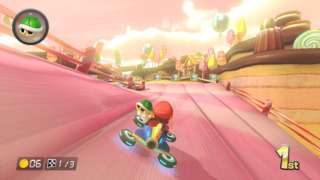
For me it’s that online component that’s most important, and helps set Mario Kart 8 apart from the rest of the series, especially in 2014. I don’t necessarily cotton to the “Mario Kart Alpha Theory”, which states that everyone’s favorite Mario Kart game is their first one. I think it’s more likely that most people’s favorite Mario Kart game is the one they were most easily able to play with a group of local friends. Mario Kart is an inherently social game, and often times there’s that one Mario Kart that came out at just the right time to facilitate that, whether it was you first Kart or not. Super Mario Kart was my first, but I played a lot more Double Dash!! than any of them thanks to where I was at in life, with plenty of friends around to play with. Hence, Double Dash!! is my favorite. Nowadays, however, my friends and I are ostensibly grown-ups, and local Mario Kart play is much less feasible. Mario Kart 8 still offers local play for those who can support it, but also has a robust selection of online modes for the rest of us. Being able to view the series as something more than a local party game opens up a lot more possibilities, and even if Mario Kart 8 doesn’t necessarily do more than cover the online basics, it still does those basics well (much better than previous online Mario Karts I’ve played). Nintendo is only recently starting to embrace online play, and being able to effectively race with friends who live far away is enough for now. Though maybe next time they can develop proper party and voice chat features for their consoles...
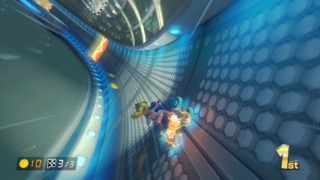
As for the game itself, it’s more or less a bigger, better version of the Mario Kart we’ve always known. The most obvious improvement is the visuals; we’re still in the process of seeing Nintendo’s franchises transition to HD, and the results remain great. The kart handling also continues to be refined, and if it’s only marginally improved from what I remember it feeling like in Mario Kart Wii, it still feels better than it ever has before. Power-sliding just feels right to me in Mario Kart 8, and the game’s well designed tracks give you all sorts of opportunities to exercise those sliding skills. In fact, with their rapid successions of curves, jumps, and anti-gravity sections, the new courses in Mario Kart 8 might be the busiest and most intense in the series. Toss in tricks, and how quickly you’re punished for going off the road, and this is almost certainly the most skill based Mario Kart game yet, which I’m in favor of. That’s not to say an unlucky blue shell still can’t ruin your day; in fact, the AI can feel downright ruthless with their items sometimes. But I feel that the actual racing mechanics and new courses reward clean driving more than ever. Nothing here is a revolution, but these gameplay tweaks, along with the addition of online play, have me enjoying Mario Kart 8 quite a lot. Who knows, given enough time it could even overtake Double Dash!! for top honors.
Patapon 2
I don’t know that I have a whole lot to say about Patapon 2 specifically, as I only played it for a few hours. Rather, I have some more general thoughts on Patapon as a concept and a franchise. After playing through the entirety of the first Patapon last summer, and now enough of the second to know I don’t want to play any more of it, this series that I expected to really like has turned out to be something I find pretty middling. The idea of a weird rhythm/strategy mix sounds cool, and Patapon has the aesthetic and charm to pull me in. Seeing it in action was one of the main things that always made me wish I had a PlayStation Portable, and it was at the top of my PSP list that pushed me to get a PlayStation Vita in the first place. Sadly, that long standing desire to play the series only serves to make my failed appreciation of it that much more disheartening.
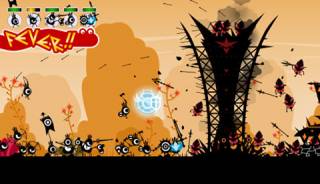
That said, I don’t hate Patapon by any stretch. I stuck with the first game through to the end after all, and some parts of the series I still like just fine. Primarily, I really like the rhythm aspect of the core gameplay. Issuing commands in rhythm is regularly mesmerizing, and it gives the battles a certain beat that’s easy to get sucked into. The music is also hella catchy (even if there’s not enough of it), and the entire look and feel of the series is quirky and endearing in all the right ways. But most everything else about the the games’ flow doesn’t sit that well with me. While the basic rhythm of the combat is good at its core, there isn’t nearly enough variety to stretch it out as long as they attempt to. Between the games, I’ve seen a total of five or six commands at most, and a similar amount of unit types. Having to input those handful of commands (which take mere seconds to execute) for those handful of unit types (none of which you have direct, individual control over) for a dozen hours or more wears way too thin, way too fast. It didn’t take long to realize that while the core idea is cool, it was going to need something a little extra to make it hold up over the long haul. Some way to continually augment your functionality could have gone a long way to give Patapon some much needed legs.
Instead, Patapon tries to stretch itself out in a much more direct, and ultimately duller way. Namely, the games add a thin layer of RPG ideas to proceedings, encouraging you to grind for money and materials to improve the status of your troops. While that’s a fine thing to have in a game, it’s not sufficient to keep a game interesting for long all by itself. Simply improving your stats does nothing to alter functionality, meaning the actual gameplay doesn’t change; the numbers are merely getting bigger. Furthermore, Patapon’s difficulty curve is very uneven, to the point where I frequently feel I need better gear and/or stats to advance. This implies grinding, which I don’t think is the best thing you can implement for a rhythm game, especially in one with such a small set of commands and music. All of this came together to create a situation where I felt like I had to spend the bulk of my time replaying levels and fiddling in menus, all to make the numbers go up without changing the actual gameplay experience. In other words, it made the game feel busy and bloated without really doing much at all. Patapon somehow manages to do very little with what seems like a lot; I personally prefer it when games can do a lot with very little. As such, all that stretched out busywork eventually weighed me down, and while I managed to see the first game through to the end, once I realized Patapon 2 wasn’t going to allay my grievances I decided it wasn’t worth it. I still think Patapon is a cool idea in general, but it needs to be a tighter game for me to enjoy it at any reasonable length.
Tactics Ogre: Let Us Cling Together
Starting Tactics Ogre: Let Us Cling Together at roughly the same time as Patapon 2 turned out to be, ironically, a weirdly parallel experience in some ways. Like Patapon, Tactics Ogre is one of the PSP games that drove me to get a Vita. And also like Patapon, Tactics Ogre demands a certain amount of grinding, and a lot of fiddling in (poorly designed) menus to set up gameplay that ultimately doesn’t change that much during the course of what’s a very lengthy game. The big difference is that Tactics Ogre’s core gameplay is much more intricate than Patapon’s, and better lends itself to a long game. I’ve always inherently enjoyed turn based tactical RPGs, and that appreciation carries over to Tactics Ogre. As of now I would guess I’m just over halfway, and while it’s a slow burn in some respects, I would like to eventually see Tactics Ogre through to its conclusion.
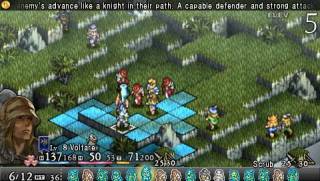
As for the actual gameplay of Tactics Ogre, while I certainly enjoy it overall, I wouldn’t say it’s one of my favorite tactical RPGs. The maps and scenarios aren’t as ambitious and strategic as Fire Emblem’s, the unit customization isn’t nearly as robust as Final Fantasy Tactics’, and the balance between the battles and “meta game” isn’t nearly as fine as XCOM’s (it’s weighed much more towards the “meta game” here, which is not my preferred balance). There’s a bit of a sense of “going through the motions”, without an added spark to stand out on its own. In some ways, that makes sense; this is a remake of a game that preceded, and from my understanding inspired the original Final Fantasy Tactics (to which it bears the closest resemblance among games I’ve played). And to be fair, the core of Tactics Ogre holds up well enough in 2014, but I still would enjoy the game more if it could somehow separate itself from the pack. As it stands, it’s purely my general appreciation of the genre that’s carrying me though. Maneuvering a group of varied troops around a battlefield in turn-based fashion has always held a strange appeal to me, and Tactics Ogre hits those beats well. It also helps that it boasts some sharp writing (even if the overarching story is kind of nonsense), and there are even some branching story paths. I have no idea how big of a difference the choices you make have on the game in the end, but I feel like that’s something the game could have potentially leveraged a little more to help stand out. The choices I’ve made have been interesting, but there haven’t been enough of them. Otherwise, I don’t really know what else to say about Tactics Ogre, weirdly enough. It’s a large, complex and time-consuming tactical RPG that nonetheless hits all the beats you would expect, which leaves me at a loss of unique, interesting things to say. I am enjoying it and plan to see it through, after which it’s possible I’ll have more to say about it. We’ll see.
Looking Ahead to July
As I alluded to in my opening sentence, the final week of June got real busy, real fast. School has finally started in earnest, and the first week gave me a good idea of just how busy these next ten months are going to be; it’s a pretty intense program. As such, I’m not really sure exactly how much gaming time I’ll have going forward, but the good news is that there aren’t a lot of games coming out in the near future either. In fact, I can’t think of a single game announced for release in July that interests me. That leaves me to continue working on Tactics Ogre, and to try and squeeze in as many other games as I can before the always packed Fall. I’ve just started Valdis Story: Abyssal City (a curiosity I picked up in the Steam sale), and Child of Light follows it at the top of my list. I have plenty of other ideas if time allows, but for now I’m keeping it simple, and we’ll see how it goes!
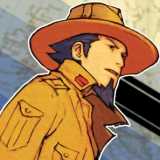
0 Comments